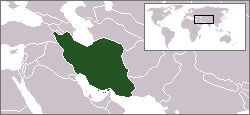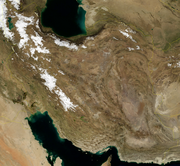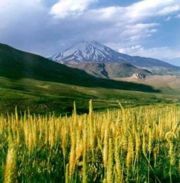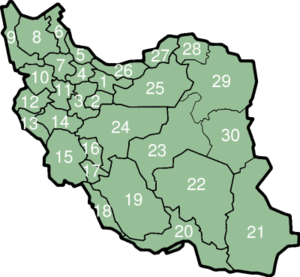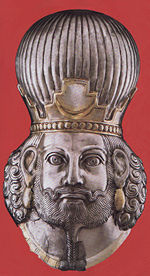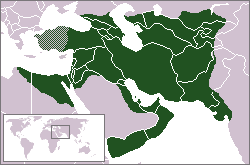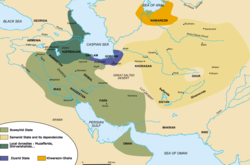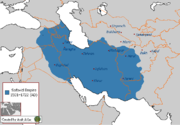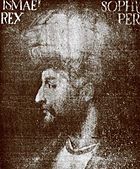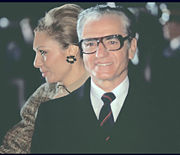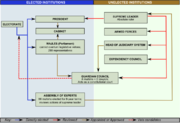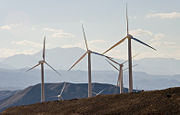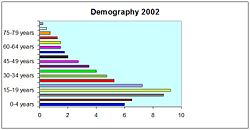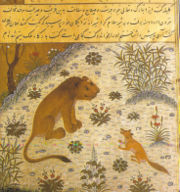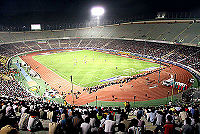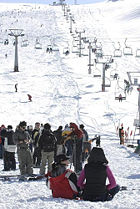Iran
2008/9 Schools Wikipedia Selection. Related subjects: Middle Eastern Countries
| جمهوری اسلامی ايران Jomhūrī-ye Eslāmī-ye Īrān Islamic Republic of Iran
|
||||||
|---|---|---|---|---|---|---|
|
||||||
| Motto: Esteqlāl, āzādī, jomhūrī-ye eslāmī 1 (Persian) "Independence, freedom, Islamic Republic" |
||||||
| Anthem: Sorūd-e Mellī-e Īrān ² |
||||||
|
|
||||||
| Capital (and largest city) |
Tehran |
|||||
| Official languages | Persian | |||||
| Demonym | Iranian | |||||
| Government | Islamic Republic | |||||
| - | Supreme Leader | Ayatollah Ali Khamenei | ||||
| - | President | Mahmoud Ahmadinejad | ||||
| Unification | ||||||
| - | Unified by Cyrus the Great | 559 BCE | ||||
| - | Parthian (Arsacid) dynastic empire (first reunification) |
248 BCE – 224 CE | ||||
| - | Sassanid dynastic empire |
224–651 CE | ||||
| - | Safavid dynasty (second reunification) |
May 1502 | ||||
| - | First Constitution | 1906 | ||||
| - | Islamic Revolution | 1979 | ||||
| Area | ||||||
| - | Total | 1,648,195 km² ( 18th) 636,372 sq mi |
||||
| - | Water (%) | 0.7 | ||||
| Population | ||||||
| - | 2006 (1385 AP) census | 70,472,846³ ( 18th) | ||||
| - | Density | 42/km² ( 158th) 109/sq mi |
||||
| GDP ( PPP) | 2007 estimate | |||||
| - | Total | $852 billion (2007) ( 15th) |
||||
| - | Per capita | $12,300 ( 65th) |
||||
| GDP (nominal) | 2005/2006 estimate | |||||
| - | Total | $222,889 billion ( 29nd) | ||||
| - | Per capita | $3,920 ( 89nd) | ||||
| Gini (1998) | 43.0 (medium) | |||||
| HDI (2007) | ▲ 0.759 (medium) ( 94th) | |||||
| Currency | Iranian rial (ريال) ( IRR) |
|||||
| Time zone | IRST ( UTC+3:30) | |||||
| - | Summer ( DST) | not observed ( UTC+3:30) | ||||
| Internet TLD | .ir | |||||
| Calling code | +98 | |||||
| 1 | bookrags.com | |||||
| 2 | iranchamber.com | |||||
| 3 | Statistical Centre of Iran. تغییرات جمعیت کشور طی سالهای ۱۳۳۵-۱۳۸۵ (Persian). Retrieved on 2007- 05-16. | |||||
| 4 | CIA Factbook | |||||
Iran, ( Persian: ايران, [ʔiˈɾɒn] ēränˈ, ĭrănˈ), officially the Islamic Republic of Iran ( Persian: جمهوری اسلامی ايران, pronounced [dʒomhuɾije ʔeslɒmije ʔiɾɒn]), formerly known internationally as Persia until 1935, is a country in Central Eurasia. Located in the heart of the Persian Gulf, an important oil-producing area, Iran is bounded by the Gulf of Oman to its south-east and the Caspian Sea to its north. Shi'a Islam is the official religion, and Persian is the official language The 18th largest country in the world in terms of area at 1,648,195 km², Iran has a population of over seventy million. Iran borders Armenia, Azerbaijan, Turkmenistan, Kazakhstan and Russia to the north, Afghanistan and Pakistan to the east, and Turkey and Iraq to the west.
Iran is home to one of the world's oldest continuous major civilizations, with historical and urban settlements dating back to 4000 BCE. Throughout history, Iran has been of geostrategic importance because of its central location in Eurasia and is a regional power. Iran is a founding member of the UN, NAM, OIC, and OPEC. The political system of Iran, based on the 1979 Constitution, comprises several intricately connected governing bodies. The highest state authority is the Supreme Leader, currently Ayatollah Ali Khamenei.
Iran occupies an important position in international energy security and world economy due to its large reserves of petroleum and natural gas. The name Iran is a cognate of Aryan, and means "Land of the Aryans". "Land of Kindness" (سرزمين مهر) is used as an alternative name for Iran in Persian literature and Iranian media.
Etymology
The term Iran (ایران) in modern Persian derives from the Proto-Iranian term Aryānām first attested in Zoroastrianism's Avesta tradition. Ariya- and Airiia- are also attested as an ethnic designator in Achaemenid inscriptions. The term Ērān from Middle Persian Ērān, Pahlavi ʼyrʼn, is found at the inscription that accompanies the investiture relief of Ardashir I at Naqsh-e Rustam. In this inscription, the king's appellation in Middle Persian contains the term ērān (Pahlavi: ʼryʼn), while in the Parthian language inscription that accompanies it, Iran is mentioned as aryān. In Ardashir's time ērān retained this meaning, denoting the people rather than the state.
Notwithstanding this inscriptional use of ērān to refer to the Iranian peoples, the use of ērān to refer to the empire is also attested by the early Sassanid period. An inscription of Shapur I, Ardashir's son and immediate successor, apparently "includes in Ērān regions such as Armenia and the Caucasus which were not inhabited predominantly by Iranians." In Kartir's inscriptions the high priest includes the same regions in his list of provinces of the antonymic Anērān. Both ērān and aryān comes from the Proto-Iranian term Aryānām, (Land) of the (Iranian) Aryas. The word and concept of Airyanem Vaejah is present in the name of the country Iran (Lit. Land of the Aryans) where Iran (Ērān), is modern-Persian of the word Aryānā.
Since the Iranian Revolution of 1979, the official name of the country is "Islamic Republic of Iran."
In the outside world the official name of Iran from 6th century BC until 1935 was Persia. In this year Reza Shah asked International community to call this country by its native name "Iran". A few years later some Persian scholars protested the government that changing the name has separated the country from its past so in 1959 Mohammad Reza Shah announced both terms can be used interchangeably. Now both terms are common but "Iran" mostly in modern political context and "Persia" in cultural and historical context.
Geography and climate
Iran is the eighteenth largest country in the world after Libya and before Mongolia. Its area roughly equals the size of the United Kingdom, France, Spain, and Germany combined, or slightly smaller than the state of Alaska. Its borders are with Azerbaijan (432 km/268 mi) and Armenia (35 km/22 mi) to the north-west; the Caspian Sea to the north; Turkmenistan (992 km/616 mi) to the north-east; Pakistan (909 km/565 mi) and Afghanistan (936 km/582 mi) to the east; Turkey (499 km/310 mi) and Iraq (1,458 km/906 mi) to the west; and finally the waters of the Persian Gulf and the Gulf of Oman to the south. Iran's area is 1,648,000 km² (approximately 636,300 sq mi).
Most of Iran is situated on the Iranian Plateau with the exception of the coast of the Caspian Sea and Khuzestan. Iran is one of the world's most mountainous countries, its landscape is dominated by rugged mountain ranges that separate various basins or plateaus from one another. The populous western part is the most mountainous, with ranges such as the Caucasus, Zagros and Alborz Mountains; the latter contains Iran's highest point, Mount Damavand at 5,604 m (18,386 ft), which is not only the country's highest peak but also the highest mountain on the Eurasian landmass west of the Hindu Kush. The eastern part consists mostly of desert basins like the saline Dasht-e Kavir, Iran's largest desert, located in the north-central portion of the country, and the Dasht-e Lut, in the east, as well as some salt lakes. This is because the mountain ranges are too high for rain clouds to reach these regions.
The only large plains are found along the coast of the Caspian Sea and at the northern end of the Persian Gulf, where Iran borders the mouth of the Shatt al-Arab (or the Arvand Rūd) river. Smaller, discontinuous plains are found along the remaining coast of the Persian Gulf, the Strait of Hormuz and the Sea of Oman.
Iran's climate is mostly arid or semiarid, to subtropical along the Caspian coast. On the northern edge of the country (the Caspian coastal plain) temperatures nearly fall below freezing and remain humid for the rest of the year. Summer temperatures rarely exceed 29 °C (84 °F). Annual precipitation is 680 mm (27 in) in the eastern part of the plain and more than 1,700 mm (67 in) in the western part. To the west, settlements in the Zagros Mountains basin experience lower temperatures, severe winters, sub-freezing average daily temperatures and heavy snowfall. The eastern and central basins are arid, with less than 200 mm (eight in) of rain and have occasional desert. Average summer temperatures exceed 38 °C (100 °F). The coastal plains of the Persian Gulf and Gulf of Oman in southern Iran have mild winters, and very humid and hot summers. The annual precipitation ranges from 135 to 355 mm (five to fourteen inches).
Provinces and Cities
Iran is divided into 30 provinces (ostān), each governed by an appointed governor (استاندار, ostāndār). The provinces are divided into counties ( shahrestān), and subdivided into districts ( bakhsh) and sub-districts (dehestān).
|
|
|
Iran has one of the highest urban-growth rates in the world. From 1950 to 2002 the urban proportion of the population increased from 27% to 60%. The United Nations predicts that by 2030 the urban population will form 80% of the overall population. Most of the internal migrants have settled near the cities of Tehran, Isfahan, Ahvaz, and Qom. The listed populations are from the 2006/2007 (1385 AP) census.
Tehran, with population of 7,705,036, is the largest city in Iran and is the Capital city. Tehran is home to around 11% of Iran's population. Tehran, like many big cities, suffers from severe air pollution. It is the hub of the country's communication and transport network. Mashhad is the second largest Iranian city and is one of the holiest Shi'a cities in the world as it is the site of the shrine. It is the second largest city and with a population of 2.8 million is the centre of the province of Razavi Khorasan. It's the centre of tourism in Iran and between 15 and 20 million pilgrims go to the Imam Reza's shrine every year. Other major Iranian cities include Isfahan (population 1,583,609), Tabriz (population 1,378,935) and Karaj (population 1,377,450). Isfahan is the capital of Isfahan Province. The Naghsh-e Jahan Square in Isfahan has been designated by UNESCO as a World Heritage Site. The city also contains a wide variety of Islamic architectural sites ranging from the eleventh to the nineteenth century. Tabriz is situated north of the volcanic cone of Sahand south of the Eynali mountain. Tabriz is the largest city in north-western Iran and is the capital of East Azarbaijan Province. Karaj is located in Tehran province and is situated 20 km west of Tehran, at the foot of Alborz mountains, however the city is increasingly becoming an extension of the metropolitan Tehran.
History
Parthian and Sassanid Empires (248 BCE–651 CE)
Parthia was led by the Arsacid Dynasty (اشکانیان Ashkâniân), who reunited and ruled over the Iranian plateau, after defeating the Greek Seleucid Empire, beginning in the late third century BCE, and intermittently controlled Mesopotamia between ca 150 BCE and 224 CE. These were the third native dynasty of ancient Iran and lasted five centuries. After the conquests of Media, Assyria, Babylonia and Elam, the Parthians had to organize their empire. The former elites of these countries were Greek, and the new rulers had to adapt to their customs if they wanted their rule to last. As a result, the cities retained their ancient rights and civil administrations remained more or less undisturbed.
Parthia was the arch-enemy of the Roman Empire in the east, limiting Rome's expansion beyond Cappadocia (central Anatolia). By using a heavily-armed and armoured cataphract cavalry, and lightly armed but highly-mobile mounted archers, the Parthians "held their own against Rome for almost 300 years". Rome's acclaimed general Mark Antony led a disastrous campaign against the Parthians in 36 BCE in which he lost 32,000 men. By the time of Roman emperor Augustus, Rome and Parthia were settling some of their differences through diplomacy. By this time, Parthia had acquired an assortment of golden eagles, the cherished standards of Rome's legions, captured from Mark Antony, and Crassus, who suffered "a disastrous defeat" at Carrhae in 53 BCE.
The end of the Parthian Empire came in 224 CE, when the empire was loosely organized and the last king was defeated by Ardashir I, one of the empire's vassals. Ardashir I then went on to create the Sassanid Empire. Soon he started reforming the country both economically and militarily. The Sassanids established an empire roughly within the frontiers achieved by the Achaemenids, referring to it as Erânshahr or Iranshahr,  , "Dominion of the Aryans", i.e. of Iranians), with their capital at Ctesiphon. The Romans suffered repeated losses particularly by Ardashir I, Shapur I, and Shapur II. During their reign, Sassanid battles with the Roman Empire caused such pessimism in Rome that the historian Cassius Dio wrote:
, "Dominion of the Aryans", i.e. of Iranians), with their capital at Ctesiphon. The Romans suffered repeated losses particularly by Ardashir I, Shapur I, and Shapur II. During their reign, Sassanid battles with the Roman Empire caused such pessimism in Rome that the historian Cassius Dio wrote:
| “ |
Here was a source of great fear to us. So formidable does the Sassanid king seem to our eastern legions, that some are liable to go over to him, and others are unwilling to fight at all. |
” |
In 632AD raiders from the Arab peninsula began attacking the Sassanid Empire. Iran was defeated in the Battle of al-Qâdisiyah, paving way for the Islamic conquest of Persia.
During Parthian, and later Sassanid era, trade on the Silk Road was a significant factor in the development of the great civilizations of China, Egypt, Mesopotamia, Persia, Indian subcontinent, and Rome, and helped to lay the foundations for the modern world. Parthian remains display classically Greek influences in some instances and retain their oriental mode in others, a clear expression of "the cultural diversity that characterized Parthian art and life". The Parthians were innovators of many architecture designs such as that of Ctesiphon, which bears resemblance to, and might have influenced, European Romanesque architecture. Under the Sassanids, Iran expanded relations with China, the arts, music, and architecture greatly flourished, and centres such as the School of Nisibis and Academy of Gundishapur became world renowned centres of science and scholarship.
From the fall of the Sassanid Dynasty to the Safavid Empire (652–1501)
After the Islamic conquest of Persia, Iran was annexed into the Arab Umayyad Caliphate. But the Islamization of Iran was to yield deep transformations within the cultural, scientific, and political structure of Iran's society: The blossoming of Persian literature, philosophy, medicine and art became major elements of the newly-forming Muslim civilization. Culturally, politically, and religiously, the Iranian contribution to this new Islamic civilization is of immense importance. Indeed, the culmination of Iran caused the " Islamic Golden Age".
Abu Moslem, an Iranian general , expelled the Umayyads from Damascus and helped the Abbasid caliphs to conquer Baghdad. The Abbasid caliphs frequently chose their " wazirs" (viziers) among Iranians, and Iranian governors acquired a certain amount of local autonomy. Thus in 822 CE, the governor of Khorasan, Tahir, proclaimed his independence and founded a new Persian dynasty of Tahirids. And by the Samanid era, Iran's efforts to regain its independence had been well solidified.
Attempts of Arabization thus never succeeded in Iran, and movements such as the Shuubiyah became catalysts for Iranians to regain their independence in their relations with the Arab invaders. The cultural revival of the post-Abbasid period led to a resurfacing of Iranian national identity. The resulting cultural movement reached its peak during the ninth and tenth centuries. The most notable effect of the movement was the continuation of the Persian language, the language of the Persians and the official language of Iran to the present day. Ferdowsi, Iran's greatest epic poet, is regarded today as the most important figure in maintaining the Persian language.
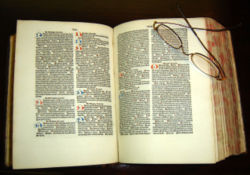
After an interval of silence Iran re-emerged as a separate, different and distinctive element within Islam. Iranian philosophy after the Islamic conquest, is characterized by different interactions with the Old Iranian philosophy, the Greek philosophy and with the development of Islamic philosophy. The Illumination School and the Transcendent Philosophy are regarded as two of the main philosophical traditions of that era in Persia.
The movement continued well into the eleventh century, when Mahmud-a Ghaznavi founded a vast empire, with its capital at Isfahan and Ghazna. Their successors, the Seljuks, asserted their domination from the Mediterranean Sea to Central Asia. As with their predecessors, the divan of the empire was in the hands of Iranian viziers, who founded the Nizamiyya. During this period, hundreds of scholars and scientists vastly contributed to technology, science and medicine, later influencing the rise of European science during the Renaissance.
In 1218, the eastern Khwarazmid provinces of Transoxiana and Khorasan suffered a devastating invasion by Genghis Khan. During this period more than half of Iran's population were killed, turning the streets of Persian cities like Neishabur into "rivers of blood", as the severed heads of men, women, and children were "neatly stacked into carefully constructed pyramids around which the carcasses of the city's dogs and cats were placed". Between 1220 and 1260, the total population of Iran had dropped from 2,500,000 to 250,000 as a result of mass extermination and famine. In a letter to King Louis IX of France, Holaku, one of the Genghis Khan's grandsons, alone took responsibility for 200,000 deaths in his raids of Iran and the Caliphate. He was followed by yet another conqueror, Tamerlane, who established his capital in Samarkand. The waves of devastation prevented many cities such as Neishabur from reaching their pre-invasion population levels until the twentieth century, eight centuries later. But both Hulagu, Timur, and their successors soon came to adopt the ways and customs of that which they had conquered, choosing to surround themselves with a culture that was distinctively Persian.
From the Safavid Dynasty to the Islamic Revolution (1501–1979)
Iran's first encompassing Shi'a Islamic state was established under the Safavid Dynasty (1501-1722) by Shah Ismail I. The Safavid Dynasty soon became a major political power and promoted the flow of bilateral state contacts. The Safavid peak was during the rule of Shah Abbas The Great. The Safavid Dynasty frequently locked horns with Ottoman Empire, Uzbek tribes and the Portuguese Empire. The Safavids moved their capital from Tabriz to Qazvin and then to Isfahan where their patronage for the arts propelled Iran into one of its most aesthetically productive eras. Under their rule, the state became highly centralized, the first attempts to modernize the military were made, and even a distinct style of architecture developed. In 1722 Afghan rebels defeated Shah Sultan Hossein and ended the Safavid Dynasty, but in 1735, Nader Shah successfully drove out the Afghan rebels from Isfahan and established the Afsharid Dynasty. He then staged an incursion into India in 1738 securing the Peacock throne, Koh-i-Noor, and Darya-ye Noor among other royal treasures. His rule did not last long however, and he was assassinated in 1747. The Mashhad based Afshar Dynasty was succeeded by the Zand dynasty in 1750, founded by Karim Khan, who established his capital at Shiraz. His rule brought a period of relative peace and renewed prosperity.
The Zand dynasty lasted three generations, until Aga Muhammad Khan executed Lotf Ali Khan, and founded his new capital in Tehran, marking the dawn of the Qajar Dynasty in 1794. The capable Qajar chancellor Amir Kabir established Iran's first modern college system, among other modernizing reforms. Iran suffered several wars with Imperial Russia during the Qajar era, resulting in Iran losing almost half of its territories to Imperial Russia and the British Empire. In spite of The Great Game Iran managed to maintain her sovereignty and was never colonized, unlike neighbouring states in the region. Repeated foreign intervention and a corrupt and weakened Qajar rule led to various protests, which by the end of the Qajar period resulted in Persia's constitutional revolution establishing the nation's first parliament in 1906, within a constitutional monarchy.
In 1921, Reza Khan overthrew the weakening Qajar Dynasty and became Shah. Reza Shah initiated industrialization, rail road construction, and the establishment of a national education system. Reza Shah sought to balance Russian and British influence, but when World War II started, his nascent ties to Germany alarmed both Britain and Russia. In 1941, Britain and the USSR invaded Iran in order to utilize Iranian rail road capacity during World War II. The Shah was forced to abdicate in favour of his son, Mohammad Reza Pahlavi. In 1951, Dr. Mohammed Mossadegh was elected prime minister. As prime minister, Mossadegh became enormously popular in Iran after he nationalized the Iran's oil reserves. In response, Britain embargoed Iranian oil and invited the United States to join in a plot to depose of Mossadegh; and, in 1953, President Eisenhower authorized Operation Ajax. The operation was successful, and Mossadegh was arrested on August 19, 1953. After Operation Ajax Mohammad Reza Pahlavi rule became increasingly autocratic. With American support, the Shah was able to rapidly modernize Iranian infrastructure, but he simultaneously crushed all forms of political opposition with his intelligence agency, SAVAK. Ayatollah Ruhollah Khomeini became an active critic of the Shah's White Revolution and publicly denounced the government. Khomeini, who was popular in religious circles, was arrested and imprisoned for 18 months. After his release in 1964, Khomeini publicly criticized the United States government. The Shah was persuaded to send him into exile by General Hassan Pakravan. Khomeini was sent first to Turkey, then to Iraq and finally to France. While in exile, he continued to denounce the Shah.
Islamic Republic (1979–)
The Iranian Revolution, also known as the Islamic Revolution, began in January 1978 with the first major demonstrations against the Shah. After strikes and demonstrations paralysed the country and its economy, the Shah fled the country in January 1979 and Ayatollah Khomeini soon returned from exile to Tehran, enthusiastically greeted by millions of Iranians. The Pahlavi Dynasty collapsed ten days later on February 11 when Iran's military declared itself "neutral" after guerrillas and rebel troops overwhelmed troops loyal to the Shah in armed street fighting. Iran officially became an Islamic Republic on April 1, 1979 when Iranians overwhelmingly approved a national referendum to make it so. In December 1979 the country approved a theocratic constitution, whereby Khomeini became Supreme Leader of the country. The speed and success of the revolution surprised many throughout the world, as it had not been precipitated by a military defeat, a financial crisis, or a peasant rebellion. Although both nationalists and Marxists joined with Islamic traditionalists to overthrow the Shah, the revolution ultimately resulted in an Islamic Republic under Ayatollah Ruhollah Khomeini.
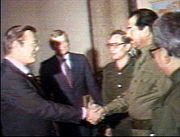
Iran's relationship with the United States deteriorated rapidly during the revolution. On November 4, 1979, a group of Iranian students seized U.S. embassy personnel, labelling the embassy a "den of spies". They accused its personnel of being CIA agents plotting to overthrow the revolutionary government, as the CIA had done to Mohammad Mossadegh in 1953. While the student ringleaders had not asked for permission from Khomeini to seize the embassy, Khomeini nonetheless supported the embassy takeover after hearing of its success. While most of the female and African American hostages were released within the first months, the remaining fifty-two hostages were held for 444 days. This is often considered a violation of the long-standing principle of international law that diplomats are immune from arrest ( diplomatic immunity). The students demanded the handover of the Shah in exchange for the hostages, and following the Shah's death in the summer of 1980, that the hostages be put on trial for espionage. Subsequently attempts by the Jimmy Carter administration to negotiate or rescue were unsuccessful until January 1981 when the Algiers declaration was agreed upon. Iraqi leader Saddam Hussein decided to take advantage of what he perceived to be disorder in the wake of the Iranian Revolution and its unpopularity with Western governments. The once-strong Iranian military had been disbanded during the revolution. Saddam sought to expand Iraq's access to the Persian Gulf by acquiring territories that Iraq had claimed earlier from Iran during the Shah's rule. Of chief importance to Iraq was Khuzestan which not only has a substantial Arab population, but boasted rich oil fields as well. On the unilateral behalf of the United Arab Emirates, the islands of Abu Musa and the Greater and Lesser Tunbs became objectives as well. With these ambitions in mind, Hussein planned a full-scale assault on Iran, boasting that his forces could reach the capital within three days. On September 22, 1980 the Iraqi army invaded Iran at Khuzestan, precipitating the Iran-Iraq War. The attack took revolutionary Iran completely by surprise.
Although Saddam Hussein's forces made several early advances, by 1982, Iranian forces managed to push the Iraqi army back into Iraq. Khomeini sought to export his Islamic revolution westward into Iraq, especially on the majority Shi'a Arabs living in the country. The war then continued for six more years until 1988, when Khomeini, in his words, "drank the cup of poison" and accepted a truce mediated by the United Nations. Tens of thousands of Iranian civilians and military personnel were killed when Iraq used chemical weapons in its warfare. Iraq was financially backed by Egypt, the Arab countries of the Persian Gulf, the Soviet Union and the Warsaw Pact states, the United States (beginning in 1983), France, the United Kingdom, Germany, Brazil, and the People's Republic of China (which also sold weapons to Iran). There were more than 100,000 Iranian victims of Iraq's chemical weapons during the eight-year war. The total Iranian casualties of the war were estimated to be anywhere between 500,000 and 1,000,000. Almost all relevant international agencies have confirmed that Saddam engaged in chemical warfare to blunt Iranian human wave attacks; these agencies unanimously confirmed that Iran never used chemical weapons during the war.
Government and politics
The political system of the Islamic Republic is based on the 1979 Constitution. The system comprises several intricately connected governing bodies. The Supreme Leader of Iran is responsible for delineation and supervision of the general policies of the Islamic Republic of Iran. The Supreme Leader is Commander-in-Chief of the armed forces, controls the military intelligence and security operations; and has sole power to declare war or peace. The heads of the judiciary, state radio and television networks, the commanders of the police and military forces and six of the twelve members of the Council of Guardians are appointed by the Supreme Leader. The Assembly of Experts elects and dismisses the Supreme Leader on the basis of qualifications and popular esteem. The Assembly of Experts is responsible for supervising the Supreme Leader in the performance of legal duties.
After the Supreme Leader, the Constitution defines the President of Iran as the highest state authority. The President is elected by universal suffrage for a term of four years and can only be re-elected for one term. Presidential candidates must be approved by the Council of Guardians prior to running in order to ensure their allegiance to the ideals of the Islamic revolution. The President is responsible for the implementation of the Constitution and for the exercise of executive powers, except for matters directly related to the Supreme Leader, who has the final say in all matters. The President appoints and supervises the Council of Ministers, coordinates government decisions, and selects government policies to be placed before the legislature. Eight Vice-Presidents serve under the President, as well as a cabinet of twenty two ministers, who must all be approved by the legislature. Unlike many other states, the executive branch in Iran does not control the armed forces. Although the President appoints the Ministers of Intelligence and Defense, it is customary for the President to obtain explicit approval from the Supreme Leader for these two ministers before presenting them to the legislature for a vote of confidence. Iran's current president, Mahmoud Ahmadinejad, was elected in a run-off poll in the 2005 presidential elections. His term expires in 2009.
The current legislature of Iran(Also known as the Majlis of Iran) is a unicameral body. Before the Iranian Revolution, the legislature was bicameral, but the upper house was removed under the new constitution. The Majlis of Iran comprises 290 members elected for four-year terms. The Majlis drafts legislation, ratifies international treaties, and approves the national budget. All Majlis candidates and all legislation from the assembly must be approved by the Council of Guardians. The Council of Guardians comprises twelve jurists including six appointed by the Supreme Leader. The others are elected by the Parliament from among the jurists nominated by the Head of the Judiciary. The Council interprets the constitution and may veto Parliament. If a law is deemed incompatible with the constitution or Sharia (Islamic law), it is referred back to Parliament for revision.
The Supreme Leader appoints the head of Iran's Judiciary, who in turn appoints the head of the Supreme Court and the chief public prosecutor. There are several types of courts including public courts that deal with civil and criminal cases, and "revolutionary courts" which deal with certain categories of offenses, including crimes against national security. The decisions of the revolutionary courts are final and cannot be appealed. The Special Clerical Court handles crimes allegedly committed by clerics, although it has also taken on cases involving lay people. The Special Clerical Court functions independently of the regular judicial framework and is accountable only to the Supreme Leader. The Court's rulings are final and cannot be appealed.
The Assembly of Experts, which meets for one week annually, comprises 86 "virtuous and learned" clerics elected by adult suffrage for eight-year terms. As with the presidential and parliamentary elections, the Council of Guardians determines candidates' eligibility. The Assembly elects the Supreme Leader and has the constitutional authority to remove the Supreme Leader from power at any time. As all of their meetings and notes are strictly confidential, the Assembly has never been publicly known to challenge any of the Supreme Leader's decisions.
Finally, Local City Councils are elected by public vote to four-year terms in all cities and villages of Iran. According to article seven of Iran's Constitution, these local councils together with the Parliament are "decision-making and administrative organs of the State". This section of the constitution was not implemented until 1999 when the first local council elections were held across the country. Councils have many different responsibilities including electing mayors, supervising the activities of municipalities; studying the social, cultural, educational, health, economic, and welfare requirements of their constituencies; planning and co-ordinating national participation in the implementation of social, economic, constructive, cultural, educational and other welfare affairs.
Economy
Iran's economy is a mixture of central planning, state ownership of oil and other large enterprises, village agriculture, and small-scale private trading and service ventures. Its economic infrastructure has been improving steadily over the past two decades but continues to be affected by inflation and unemployment. Iran's official annual growth rate is at 6%. In the early twenty-first century the service sector contributed the largest percentage of the GDP, followed by industry ( mining and manufacturing) and agriculture. In 2006, about 45% of the government's budget came from oil and natural gas revenues, and 31% came from taxes and fees. Government spending contributed to an average annual inflation rate of 14% in the period 2000–2004. In 2007, the GDP was estimated at $206 billion ($852 billion at PPP), or $3,160 per capita ($12,300 at PPP). Because of these figures and the country’s diversified but small industrial base, the United Nations classifies Iran's economy as semi-developed.
The services sector has seen the greatest long-term growth in terms of its share of GDP, but the sector remains volatile. State investment has boosted agriculture with the liberalization of production and the improvement of packaging and marketing helping to develop new export markets. Thanks to the construction of many dams throughout the country in recent years, large-scale irrigation schemes, and the wider production of export-based agricultural items like dates, flowers, and pistachios, produced the fastest economic growth of any sector in Iran over much of the 1990s. Although successive years of severe drought in 1998, 1999, 2000 and 2001 have held back output growth substantially, agriculture remains one of the largest employers, accounting for 22% of all jobs according to the 1991 census. Iran's major commercial partners are China, Germany, South Korea, France, Japan, Russia and Italy.

Since the late 1990s, Iran has increased its economic cooperation with other developing countries, including Syria, India, Cuba, Venezuela, and South Africa. Iran is expanding its trade ties with Turkey and Pakistan and shares with its partners the common goal of creating a single economic market in West and Central Asia, called ECO. Iran expects to attract billions of dollars of foreign investment by creating a more favorable investment climate, such as reduced restrictions and duties on imports, and free-trade zones in Chabahar, Qeshm and Kish Island.
The administration continues to follow the market reform plans of the previous one and indicated that it will diversify Iran's oil-reliant economy. It is attempting to do this by investing revenues in areas like automobile manufacturing, aerospace industries, consumer electronics, petrochemicals and nuclear technology. Iran has also developed a biotechnology, nanotechnology, and pharmaceuticals industry. The strong oil market since 1996 helped ease financial pressures on Iran and allowed for Tehran's timely debt service payments. Iranian budget deficits have been a chronic problem, in part due to large-scale state subsidies, totaling more than $40 billion per year, that include foodstuffs and especially gasoline.
Energy
Iran ranks second in the world in natural gas reserves and third in oil reserves. In 2005, Iran spent US$4 billion dollars on fuel imports, because of contraband and inefficient domestic use. Oil industry output averaged 4 million barrels per day in 2005, compared with the peak of six million barrels per day reached in 1974. In the early 2000s, industry infrastructure was increasingly inefficient because of technological lags. Few exploratory wells were drilled in 2005.
In 2004, a large share of Iran’s natural gas reserves were untapped. The addition of new hydroelectric stations and the streamlining of conventional coal- and oil-fired stations increased installed capacity to 33,000 megawatts. Of that amount, about 75% was based on natural gas, 18% on oil, and 7% on hydroelectric power. In 2004, Iran opened its first wind-powered and geothermal plants, and the first solar thermal plant is to come online in 2009. Demographic trends and intensified industrialization have caused electric power demand to grow by 8% per year. The government’s goal of 53,000 megawatts of installed capacity by 2010 is to be reached by bringing on line new gas-fired plants and by adding hydroelectric, and nuclear power generating capacity. Iran’s first nuclear power plant at Bushehr was not online by 2007.
Industrial production
The authorities so as the private sector have put in the past 15 years an emphasis on the local production of domestic-consumption oriented goods such as home appliances, cars, agricultural products, pharmaceutical, etc. Today, Iran possesses a good manufacturing industry, despite restrictions imposed by foreign countries. However, nationalized industries such as the bonyads have often been managed badly, making them ineffective and uncompetitive with years. Today, the government is trying to privatize these industries, such as Damavand Mineral water company or some down stream industries of the National Iranian Oil Company, and despite some successes, there are still several problems to be overcome such as the lagging corruption in the public sector (and therefore, nationalized industries) and lack of competitiveness.
Globally, Iran has leading manufacture industry in the fields of car-manufacture and transportations, construction materials, home appliances, food and agricultural goods, armaments, pharmaceuticals, information technology and petrochemicals.
Tourism
The tourist industry declined dramatically during the war with Iraq in the 1980s but has subsequently revived. The majority of the 300,000 tourist visas granted in 2003 were obtained by Asian Muslims, who presumably intended to visit important pilgrimage sites in Mashhad and Qom. About 1,659,000 foreign tourists visited Iran in 2004; most came from Asian countries, including the republics of Central Asia, while a small share came from the countries of the European Union and North America. Several organized tours from Germany, France, and other European countries come to Iran annually to visit archaeological sites and monuments. The government reported that in 2004 some four million tourists, including over two million Iranians on vacation, spent nearly US$2 billion in Iran, an increase of 10% over 2003. However, in the early 2000s the industry still faced serious limitations in infrastructure, communications, regulatory norms, and personnel training.
Iran currently ranks 68th in tourism revenues worldwide. Iran with attractive natural and historical sites is rated among the 10 most touristic countries in the world. Close to 1.8% of national employment is generated in the tourism sector which is slated to increase to 10% in the next five years.
Demography
Iran is a diverse country consisting of people of many religions and ethnic backgrounds cemented by the Persian culture. Persians constitute the majority of the population. 70% of present-day Iranians are Iranic peoples, native speakers of Iranian branches of the Indo-European languages. The majority of the population speaks the official language, Persian, or another Iranian language or dialect, however Arabic is also spoken by the Arabic minority, (ie. in the south, in provinces like Khuzestan), and Turkic dialects, (ie. Azeri, etc). are spoken by the Turkic minority (ie. in the north, in provinces like Tabriz). The main ethnic groups are Persians (51%), Azeris (24%), Gilaki and Mazandarani (8%), Kurds (7%), Arabs (3%), Baluchi (2%), Lurs (2%), Turkmens (2%), Laks, Qashqai, Armenians, Persian Jews, Georgians, Assyrians, Circassians, Tats, Pashtuns, Mandaeans, Gypsies, Brahuis, Hazara and others (1%).
Iran's population increased dramatically during the latter half of the twentieth century, reaching about 70 million by 2006. In recent years, however, Iran's birth rate has dropped significantly. Studies show that Iran's rate of population growth will continue to slow until it stabilizes, by the year 2050, above 90 million. More than two-thirds of the population is under the age of 30, and the literacy rate is 79%.
There are some four million Iranian peoples who emigrated to North America, Europe, and Australia, mostly during the Iran-Iraq war. Iran also hosts one of the largest refugee population in the world, with more than one million refugees, mostly from Afghanistan and Iraq. Since 2006, Iranian officials have been working with the UNHCR and Afghan officials for their repatriation.
Most Iranians are Muslims; 90% belong to the Shi'a branch of Islam, the official state religion, and about 8% belong to the Sunni branch, mainly Kurds and Iran's Balochi Sunni. The remaining 2% are non-Muslim religious minorities, including Bahá'ís, Mandeans, Hindus, Sikhs, Yezidis, Yarsanis, Zoroastrians, Jews, and Christians. The latter three minority religions are officially recognized and protected, and have reserved seats in the Majles (Parliament). However the Bahá'í Faith, Iran's largest religious minority, is not officially recognized, and has been persecuted during its existence in Iran. Since the 1979 revolution the persecution of Bahá'ís has increased with executions, the denial of civil rights and liberties, and the denial of access to higher education and employment. Currently, the Islamic Republic of Iran is noted for significant human rights violations, despite efforts by human right activists, writers, NGOs and some political parties. Human rights violations include governmental impunity, restricted freedom of speech, gender inequality, treatment of homosexuals, execution of minors, and in some cases torture.
According to the Iranian Constitution, the government is required to provide every citizen of the country with access to social security that covers retirement, unemployment, old age, disability, accidents, calamities, health and medical treatment and care services. This is covered by public revenues and income derived from public contributions. The World Health Organization in the last report on health systems ranks Iran's performance on health level 58th, and its overall health system performance 93rd among the world's nations.
Foreign relations and military
This image is a candidate for speedy deletion. It may be deleted after seven days from the date of nomination.
Iran's foreign relations are based on two strategic principles: eliminating outside influences in the region and pursuing extensive diplomatic contacts with developing and non-aligned countries. Iran maintains diplomatic relations with almost every member of the United Nations, except for Israel, which Iran does not recognize, and the United States since the Iranian Revolution. Since 2005, Iran's Nuclear Program has become the subject of contention with the West because of suspicions regarding Iran's military intentions. This has led the UN Security Council to impose sanctions against Iran on select companies linked to this program, thus furthering its economic isolation on the international scene.
The Islamic Republic of Iran has two kinds of armed forces: the regular forces Islamic Republic of Iran Army, Islamic Republic of Iran Air Force, Islamic Republic of Iran Navy and the Islamic Revolutionary Guards Corps (IRGC), totalling about 545,000 active troops. Iran also has around 350,000 Reserve Force totalling around 900,000 trained troops.
Iran also has a paramilitary, volunteer militia force within the IRGC, called the Basij, which includes about 90,000 full-time, active-duty uniformed members. Up to 11 million men and women are members of the Basij who could potentially be called up for service; GlobalSecurity.org estimates Iran could mobilize "up to one million men". This would be among the largest troop mobilizations in the world.
Iran's military capabilities are kept largely secret. Since 1992, it has produced its own tanks, armored personnel carriers, guided missiles, submarines, and fighter planes. In recent years, official announcements have highlighted the development of weapons such as the Fajr-3 (MIRV), Hoot, Kowsar, Zelzal, Fateh-110, Shahab-3 missiles, and a variety of unmanned aerial vehicles (UAVs).
The Fajr-3 (MIRV) is currently Iran's most advanced ballistic missile. It is a domestically-developed and produced liquid fuel missile with an unknown range. The IRIS solid-fuelled missile is a program which is supposed to be Iran's first missile to bring satellites into orbit. In 2005, Iran's military spending represented 3.3% of the GDP or $91 per capita, the lowest figure of the Persian Gulf nations. Iran's military doctrine is to defend its territorial integrity only.
Culture
The Indo-Iranian culture probably originated in Central Asia. The Andronovo culture is strongly suggested as the candidate for the common Indo-Iranian culture ca. 2000 BCE. Iran, as a historical entity, dates to the time of the Achaemenids. Daily life in modern Iran is closely interwoven with Shia Islam and the country's art, literature, and architecture are an ever-present reminder of its deep national tradition and of a broader literary culture. Iranian culture has long been a predominant culture of the Middle East and Central Asia, with Persian considered the language of intellectuals during much of the second millennium CE, and the language of religion and the populace before that.
The Iranian New Year ( Norouz) is an ancient tradition celebrated on March 21 to mark the beginning of spring in Iran, Afghanistan, Albania, Georgia, Turkmenistan, and Kazakhstan. and also by Kurds in Turkey and Iraq. Norouz was nominated as one of UNESCO's Masterpieces of the Oral and Intangible Heritage of Humanity in 2004.
The Sassanid era was an important and influential historical periods in Iran Their cultural influenced Roman civilization considerably and so influencing as far as Western Europe, Africa, China and India and also playing a prominent role in the formation of both European and Asiatic medieval art. This influence carried forward to the Islamic world. Most of what later became known as Islamic learning, such as philology, literature, jurisprudence, philosophy, medicine, architecture and the sciences were some of the practises taken from the Sassanid Persians in to the broader Muslim world. After the Arab invasion Islamic rituals have penetrated in the Iranian culture. The most noticeable one of them is commemoration of Husayn ibn Ali. Every year in Day of Ashura most of Iranians even Armenians and Zoroastrians participate in mourning for the martyrs of battle of Karbala. The commemoration of Karbala has permeated all of Persian culture and finds expression in poetry, music, and the solemn Shia view of the world.
The cuisine of Iran is diverse, with each province featuring dishes, as well as culinary traditions and styles, distinct to their region. Iranian food is not spicy. Most meals consist of a large serving of seasoned rice and an accompanying course, typically consists of meat, poultry, or fish. Herbs are used frequently. Onions and garlic are normally used in the preparation of the accompanying course, but are also served separately during meals, either in raw or pickled form.
There is no consensus on the origin of the first hand-made carpet, but the discovery of the “Pazirik” carpet proves the great role of Iranians in creating this valuable art.
Iranian cinema has thrived in modern Iran, and many Iranian directors have garnered worldwide recognition for their work. Iranian movies have won over three hundred awards in the past twenty-five years. One of the best-known directors is Abbas Kiarostami. The Media of Iran is a mixture of private and state-owned, but books and movies must be approved by the Ministry of Culture and Islamic Guidance before being released to the public. State censorship is often brought upon films which do not meet approval. The Internet has become enormously popular among the Iranian youth. Iran is now the world's fourth largest country of bloggers. Women today compose more than half of the incoming classes for universities around the country and increasingly continue to play pivotal roles in society.
Language and literature
Many languages have originated from Iran such as Mazandarani and Gilaki, but Persian is the most used language. Persian is a tongue belonging to the Aryan or Indo-Iranian branch of the Indo-European family of languages. The oldest records in Old Persian date back to the Achaemenid Empire and examples of Old Persian have been found in present-day Iran, Iraq, Turkey and Egypt. Since then it has changed significantly, being greatly influenced by Arabic after the conquest of Persia. In the late eighth century the Persian language was highly Arabized and written in a modified Arabic script. This caused a movement supporting the revival of Persian. An important event of this revival was the writing of the Shahname by Ferdowsi (Persian: Epic of Kings), Iran's national epic, which is said to have been written entirely in native Persian. This gave rise to a strong reassertion of Iranian national identity, and is in part responsible for the continued existence of Persian as a separate language.
| “ |
عجم زنده کردم بدین پارسی For thirty years, I suffered much pain and strife |
” |
Persian beside Arabic has been a medium for literary and scientific contributions to the Islamic world especially in Anatolia, central Asia and Indian sub-continent. Poetry is a very important part of Persian culture. Poetry is used in many classical works, whether from Persian literature, science, or metaphysics. For example about half of Avicenna's medical writings are known to be versified. Iran has produced a number of famous poets, however only a few names such as Rumi and Omar Khayyám have surfaced among western popular readership, even though the likes of Hafez and Saadi are considered by many Iranians to be just as influential. The books of famous poets have been translated into western languages since 1634. An example of Persian poetic influence is the poem below which is inscribed on the entrance of United Nations' Hall of Nations.
| “ |
که در آفرينش ز يک گوهرند چو عضوى بدرد آورد روزگارد دگر عضوها را نماند قرار Of one Essence is the human race |
” |
Art
Greater Iran is home to one of the richest artistic traditions in world history and encompasses many disciplines, including architecture, painting, weaving, pottery, calligraphy, metalworking and stone masonry. Persians were among the first to use mathematics, geometry, and astronomy in architecture and also have extraordinary skills in making massive domes which can be seen frequently in the structure of bazaars and mosques. The main building types of classical Iranian architecture are the mosque and the palace. Iran, besides being home to a large number of art houses and galleries, also holds one of the largest and valuable jewel collections in the world.
Iran ranks seventh among countries in the world with the most archeological architectural ruins and attractions from antiquity as recognized by UNESCO. Fifteen of UNESCO's World Heritage Sites are creations of Iranian architecture and the mausoleum of Maussollos was identified as one of the Seven Wonders of the Ancient World.
Science and technology
Science in Iran has a considerable history. From the Qanat to the Yakhchal, to the windmill. Iranians contributed significantly to the current understanding of astronomy, nature, medicine, mathematics, and philosophy. Muhammad ibn Mūsā al-Khwārizmī is sometimes considered (along with Diophantus) as the "father of Algebra". The isolation of ethanol (alcohol) as a pure compound was first achieved by Persian alchemists. Throughout the Middle Ages, the natural philosophy and mathematics of the ancient Greeks and Persians were furthered and preserved within Persia. The Academy of Gundishapur was a renowned centre of learning in the city of Gundeshapur during late antiquity and was the most important medical centre of the ancient world during the sixth and seventh centuries. During this period, Persia became a centre for the manufacture of scientific instruments, retaining its reputation for quality well into the nineteenth century.
Iran strives to revive the golden age of Persian science. The country has increased its publication output nearly tenfold from 1996 through 2004, and has been ranked first in terms of output growth rate followed by China.
Despite the limitations in funds, facilities, and international collaborations, Iranian scientists remain highly productive in several experimental fields as pharmacology, pharmaceutical chemistry, organic chemistry, and polymer chemistry. Iranian scientists are also helping construct the Compact Muon Solenoid, a detector for CERN's Large Hadron Collider due to come online in May 2008.
In the biomedical sciences, Iran's Institute of Biochemistry and Biophysics is a UNESCO chair in biology, and in late 2006, Iranian scientists successfully cloned a sheep by somatic cell nuclear transfer, at the Rouyan research centre in Isfahan.
The Iranian nuclear program was launched in the 1950s. Iran's current facilities includes several research reactors, a uranium mine, an almost complete commercial nuclear reactor, and uranium processing facilities that include a uranium enrichment plant. The Iranian Space Agency launched its first reconnaissance satellite named Sina-1 in 2006, and a "space rocket" in 2007, which aimed at improving science and research for university students.
Iranian scientists are a significant portion of the international scientific community. In 1960, Ali Javan co-invented the first gas laser, along with American physicist William R. Bennett, Jr. In 1965, fuzzy set theory was introduced by Lotfi Zadeh. Iranian cardiologist, Tofy Mussivand invented the first artificial cardiac pump, the precursor of the artificial heart, and developed it further afterwards. HbA1c was discovered by Samuel Rahbar and introduced to the medical community, thereby furthering research and treatment of Diabetes. Iranian physics is especially strong in string theory, with many papers being published in Iran. Iranian-American string theorist Cumrun Vafa proposed the Vafa-Witten theorem together with Edward Witten. The KPZ equation in theoretical physics was named after Mehran Kardar.
Sports
With two thirds of Iran's population under the age of 25, sports constitutes a highly active portion of Iran's society, both traditional and modern. Iran hence was the birthplace of sports such as polo, backgammon, and Varzesh-e Pahlavani.
Freestyle Wrestling is traditionally referred to as Iran's national sport. Former WWF champion Iron Sheik wrestled as an amateur in Iran before moving to the United States but today, the most popular sport in Iran is football (soccer), with national team being a World Cup finalist three times, having won the Asian Cup on three occasions and was the first country in the Middle East to host the Asian Games. Iran is home to several unique skiing resorts, with the Tochal resort being the world's fifth-highest ski resort (3,730 m/12,238 ft at its highest station) situated only fifteen minutes away from Tehran. Being a mountainous country, Iran offers enthusiasts abundant challenges for hiking, rock climbing, and mountain climbing.
Women are also active in sports, primarily in volleyball and badminton and even rallying. Female drivers participate in national rally tournaments, such as the famous driver Laleh Seddigh.


